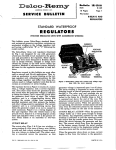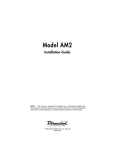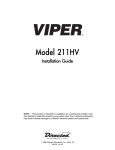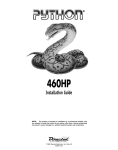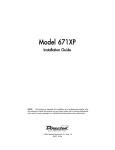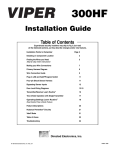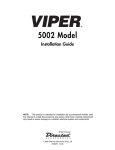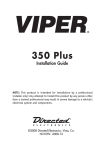Download Directed Electronics 3200 Installation guide
Transcript
3200HS Installation Guide NOTE: This product is intended for installation by a professional installer only! Any attempt to install this product by any person other than a trained professional may result in severe damage to a vehicle’s electrical system and components. © 2002 Directed Electronics, Inc. Vista, CA N416S 12-02 The Bitwriter® (p/n 998T) requires chip version 1.4 or newer to program this unit. Bitwriter™, Code Hopping™, DEI®, Doubleguard®, ESP™, FailSafe®, Ghost Switch™, Learn Routine™, Nite-Lite®, Nuisance Prevention® Circuitry, NPC®, Revenger®, Silent Mode™, Soft Chirp®, Stinger®, Valet®, Vehicle Recovery System®, VRS®, and Warn Away® are all Trademarks or Registered Trademarks of Directed Electronics, Inc. www.directechs.com DirectFax 800-999-1329 Technical Support 800-753-0800 These resources are for authorized Directed Dealer use only. Table of Contents Primary Harness (H1) Wire Connection Guide . . . . . . . . . . . . . . . . . . . . . . . . . . . . . . . . . . . .4 Primary Harness (H1) Wiring Diagram . . . . . . . . . . . . . . . . . . . . . . . . . . . . . . . . . . . . . . . .4 Primary Harness Wire Descriptions . . . . . . . . . . . . . . . . . . . . . . . . . . . . . . . . . . . . . . . . . . .4 Door Lock Harness (H4), Wire Connection Guide . . . . . . . . . . . . . . . . . . . . . . . . . . . . . . . . .8 Peripheral Plug-In Harnesses . . . . . . . . . . . . . . . . . . . . . . . . . . . . . . . . . . . . . . . . . . . . . . . . . .8 Super Bright LED, 2-Pin WHITE Plug . . . . . . . . . . . . . . . . . . . . . . . . . . . . . . . . . . . . . . . .8 Valet/Program Switch, 2-Pin BLUE Plug . . . . . . . . . . . . . . . . . . . . . . . . . . . . . . . . . . . . . . .9 Programmer Interface, 3-Pin Port . . . . . . . . . . . . . . . . . . . . . . . . . . . . . . . . . . . . . . . . . . . . .9 System Features Learn Routine . . . . . . . . . . . . . . . . . . . . . . . . . . . . . . . . . . . . . . . . . . . . . . . . .9 System Features Menus . . . . . . . . . . . . . . . . . . . . . . . . . . . . . . . . . . . . . . . . . . . . . . . . . . . . . . .11 Feature Descriptions . . . . . . . . . . . . . . . . . . . . . . . . . . . . . . . . . . . . . . . . . . . . . . . . . . . . . . . . .11 Transmitter/Receiver Learn Routine . . . . . . . . . . . . . . . . . . . . . . . . . . . . . . . . . . . . . . . . . . . . .13 Transmitter Configurations . . . . . . . . . . . . . . . . . . . . . . . . . . . . . . . . . . . . . . . . . . . . . . . . . . .15 Standard Configuration . . . . . . . . . . . . . . . . . . . . . . . . . . . . . . . . . . . . . . . . . . . . . . . . . . . .15 Single Button Arm/Disarm Configuration . . . . . . . . . . . . . . . . . . . . . . . . . . . . . . . . . . . . . .15 Rapid Resume Logic . . . . . . . . . . . . . . . . . . . . . . . . . . . . . . . . . . . . . . . . . . . . . . . . . . . . . . . . .15 Wiring Quick Reference Guide . . . . . . . . . . . . . . . . . . . . . . . . . . . . . . . . . . . . . . . . . . . . . . . . .16 © 2002 Directed Electronics, Inc. 3 Primary Harness (H1) Wire Connection Guide Primary Harness (H1) Wiring Diagram The primary harness supplied with this unit is the standard 12-pin harness used by Directed security systems. Two wires in the plug are not used. The upgrade from this unit to a security system would simply require unplugging and exchanging control units and connecting the necessary wires to the vehicle. The functions of all the wires that are used in the primary harness are outlined in the following wiring diagram and the wire connections are described in the wire connection guides. H1/1 ___ ORANGE H1/2 ___ WHITE H1/3 ___ WHITE/BLUE H1/4 ___ BLACK/WHITE H1/5 ___ GREEN H1/6 ___ BLUE H1/7 ___ VIOLET No Function H1/8 ___ BLACK (-) Chassis Ground Input H1/9 ___ YELLOW H1/10 ___ BROWN H1/11 ___ RED H1/12 ___ RED/WHITE (-) 500 mA Armed Output (-) Light Flash Output (-) 200 mA Channel 3 Validity Output (-) 200 mA Domelight Supervision Output No Function (-) 200 mA Second Unlock Output Switched Ignition Input (-) Horn Honk Output (+) Constant Power Input (-) 200 mA Channel 2 Validity Output Primary Harness Wire Descriptions H1/1 ORANGE (-) Ground-When-Armed Output This wire supplies a (-) 500 mA ground as long as the system is armed. This output ceases as soon as the system is disarmed. The orange wire is pre-wired to control the 8618 starter kill relay. NOTE: if using the H1/1 Orange wire to activate an add-on accessory such as window automation, pager or voice module a 1Amp diode must be installed to ensure proper operation. Insert the diode as shown in the following diagram. 4 © 2002 Directed Electronics, Inc. IMPORTANT! Never interrupt any wire other than the starter wire. H1/2 WHITE (-) Parking Light Output This wire provides a (-) 200mA output to flash the parking lights. This is suitable for driving (-) light control wires in Toyota, Lexus, BMW, some Mitsubishi, some Mazda, etc. If the vehicle has a positive parking light circuit, a relay must be used to flash the parking lights. H1/3 WHITE/BLUE (-) Channel 3 Output This wire provides a (-) 200 mA output whenever the transmitter code controlling Channel 3 is received. This output will continue as long as that transmission is received. Use for options such as DEI’s 551T Valet® Start system, 529T or 530T power window controllers, etc. IMPORTANT! Never use this wire to drive anything but a relay or a low-current input! The transistorized output can only provide 200 mA of current, and connecting directly to a solenoid, motor, or other high-current device will cause it to fail. H1/4 BLACK/WHITE (-) 200 mA Domelight Supervision Output Connect this wire to the optional domelight supervision relay as shown in the following diagram: IMPORTANT! This output is only intended to drive a relay. It cannot be connected directly to the domelight circuit, as the output cannot support the current draw of one or more bulbs. © 2002 Directed Electronics, Inc. 5 H1/6 BLUE (-) 200 mA Second Unlock Output The H1/6 BLUE output is used for progressive unlock. A progressive unlock system unlocks the driver's door when the unlock (disarm) button is pressed and unlocks the passenger doors if the unlock (disarm) button is pressed again within 15 seconds after unlocking the driver's door. The BLUE wire outputs a low current (-) pulse on the second press of the unlock button of the transmitter. This negative unlock output is used to unlock the passenger doors. H1/8 BLACK (-) Chassis Ground Connection Connect this wire to a clean, paint-free sheet metal location (driver kick panel) using a factory bolt that DOES NOT have any vehicle component grounds attached to it. A screw should only be used when in conjunction with a two-sided lock washer. Under dash brackets and door sheet metal are not acceptable ground points. It is recommended that all security components be grounded at the same location. H1/9 YELLOW (+) Ignition Input Connect this wire to an ignition source. This input must show (+)12V with the key in run position and during cranking. Make sure that this wire cannot be shorted to the chassis at any point. This wire will trigger the system if the ignition is turned on before the unit is disarmed (doors unlocked with the remote). It will also honk the vehicle’s horn and flash the parking lights (if connected). 6 © 2002 Directed Electronics, Inc. H1/10 BROWN (-) Horn Honk Output This wire supplies a (-) 200 mA output that can be used to honk the vehicle horn. It outputs a single pulse when locking the doors with the remote, and two pulses when unlocking with the remote. This wire will also output pulses for 30 seconds when the Panic Mode is activated. If the vehicle has a (+) horn circuit, an optional relay can be used to interface with the system, as shown below. H1/11 RED (+)12V constant power input Before connecting this wire, remove the supplied fuse. Connect to the battery positive terminal or the constant 12V supply to the ignition switch. NOTE: Always use a fuse within 12 inches of the point you obtain (+)12V. Do not use the fuse in the harness for this purpose. This fuse protects the module itself. H1/12 Red/white channel 2, 200mA (-) output When the system receives the transmitter code controlling Channel 2 for longer than 1.5 seconds, the red/white wire will supply an output as long as the transmission continues. This is often used to operate a trunk/hatch release or other relay-driven functions. IMPORTANT! Never use this wire to drive anything but a relay or a low-current input! The transistorized output can only supply 200 mA of current. Connecting directly to a solenoid, motor, or other high-current device will cause it to fail. © 2002 Directed Electronics, Inc. 7 Door Lock Harness (H4), Wire Connection Guide H4/A ___ Green (-) Lock, (+) Unlock Output H4/B ___ Empty Unless Using 451M H4/C ___ Blue (-) Unlock, (+) Lock Output IMPORTANT! The door lock outputs are low current and should not be attached directly to any high current device; they are only to be used to activate relays NOTE: For detailed instructions about connecting to the vehicle’s power door lock systems, refer to the Door Lock Wiring guide (Document No. 1041) available only to authorized dealers though the technical resources listed at the front of this guide. Peripheral Plug-In Harnesses Super Bright LED, 2-Pin WHITE Plug The super bright LED operates at (+) 2 volt DC and plugs into the two-pin WHITE port. Make sure the LED wires are not shorted to ground as the LED will be damaged. Multiple LED’s can be used, but they must be wired in series. The LED fits into a 9/32-inch mounting hole. Be sure to check for clearance prior to drilling the mounting hole. DIA-41 8 © 2002 Directed Electronics, Inc. Valet/Program Switch, 2-Pin BLUE Plug The Valet/Program button should be accessible from the driver’s seat. It plugs into the BLUE port on the side of the unit. Consider how the button will be used before choosing a mounting location. Check for rear clearance before drilling a 9/32-inch hole and mounting the button. Programmer Interface, 3-Pin Port The BLACK three-pin port is provided for programming of the unit. When using the 998T Bitwriter, it is possible to configure any and all of the programmable functions. For more information please refer to the guide packaged with the programmer. System Features Learn Routine The System Features Learn Routine dictates how the unit operates. It is possible to access and change any of the feature settings using the Valet/Program switch. However, this process can be greatly simplified by using the 998T Bitwriter. Any of the settings can be changed and then assigned to a particular transmitter, up to four, a feature called Owner Recognition. Each time that particular transmitter is used to disarm the system, the assigned feature settings will be recalled. Owner Recognition is only possible when programming the unit via the 998T Bitwriter. If the system was previously programmed using the 998T Bitwriter, the learn routine may be locked. If the horn generates one long honk when attempting to program the unit, the learn routine is locked and must be unlocked using the 998T Bitwriter before proceeding. © 2002 Directed Electronics, Inc. 9 To program the learn routine: 1. Key. Turn the ignition on and then back off. 2. Choose. Within 10 seconds, press and release the Valet®/Program switch the number of times corresponding to the feature number you want to program. (See Feature Menus.) Once the Valet®/Program switch has been pressed and released the desired number of times, press it once more and hold it. After a second, the LED will flash and the horn will honk to indicate which feature you have accessed. 3. Transmit. The transmitter is used to select the desired setting. As shipped, the unit is configured to the LED ON settings. These are the default settings. Pressing the lock button will set it to the LED ON setting. The LED will light solid (stop flashing) to indicate the setting. The horn will honk once (if connected). Pressing the unlock button will change the setting to the LED OFF setting. The LED will go out indicating the change and the horn will honk twice (if connected). 4. Release. The Valet®/Program switch can now be released. For example, to program the arming mode from active to passive, within 10 seconds of turning the ignition off, and press and release the Valet/Program switch once. Then press it again and hold it. The LED will flash in groups of one and the horn will honk once (if connected). While holding the Valet®/Program switch, press the unlock button. The LED will stop flashing and go out. The horn will honk twice if connected. Passive arming is now programmed. If that was not the desired setting, without releasing the Valet®/Program switch, press the lock button. The LED will light solid and the horn will honk once if connected. Active arming is now programmed. Release the Valet®/Program switch after the selection has been made. You can advance from feature to feature by pressing and releasing the Valet®/Program switch the number of times necessary to get from the feature you just programmed to the feature you wish to access. For example, if you just programmed Feature 2 and you next want to program Feature 3 to off, release the Valet/Program switch. Press and release it once to advance from Feature 2 to Feature 3. Then press it once more and hold it. The LED will flash in groups of three and the horn will honk three times (if connected) to confirm that you have accessed Feature 3. 10 © 2002 Directed Electronics, Inc. The learn routine will be exited if: ➤ The ignition is turned on. ➤ The Valet/Program switch is pressed too many times. ➤ More than 15 seconds elapses between programming steps. One long horn honk (if connected) indicates that the Learn Routine has been exited. System Features Menus Feature Number Default LED ON Setting (Press Channel 1) LED OFF Setting (Press Channel 2) 1 Active arming Passive arming 2 Chirps ON Chirps OFF 3 Ignition-controlled door lock ON Ignition-controlled door lock OFF 4 Ignition-controlled door unlock ON Ignition-controlled door unlock OFF 5 Active locking Passive locking 6 Ignition-controlled domelight ON Ignition-controlled domelight OFF 7 0.8 second door lock pulses 3.5 second door lock pulses 8 Double pulse unlock OFF Double pulse unlock ON 9 Security features ON Security features OFF 10 Code Hopping ON Code Hopping OFF Feature Descriptions The features of the system are described below. Features that have additional settings that can be selected only when programming with the 998T Bitwriter are indicated by the following icon: 1 ACTIVE/PASSIVE ARMING: When active arming is selected, the starter kill will arm (if connected) only when the transmitter is used. When set to passive arming, the starter kill will arm (if connected) 30 seconds after the ignition key is turned off. 2 CHIRPS ON/OFF: This feature controls the chirps that confirm arming and disarming of the system. A siren or horn must be connected to the H1/10 BROWN wire. © 2002 Directed Electronics, Inc. 11 3 IGNITION CONTROLLED DOOR LOCK ON/OFF: When turned on, the doors will lock three seconds after the ignition is turned on. 4 IGNITION CONTROLLED DOOR UNLOCK ON/OFF: When turned on, the doors will unlock when the ignition is turned off. 5 ACTIVE/PASSIVE LOCKING: If passive arming is selected in Feature 1, then the system can be programmed to either lock the doors when passive arming occurs, or only lock the doors when the system is armed with a transmitter. Active locking means the doors will not lock when the system passively arms. Passive locking means that the doors will lock whenever the system passively arms the starter kill (if connected). 6 IGNITION CONTROLLED DOMELIGHT: If turned on, the system will turn on the domelight for 30 seconds when the ignition is turned off. The domelight supervision output (H1/4) wire must be connected to an optional relay as described in the Primary Harness Wire Connection Guide. 7 DOOR LOCK PULSE DURATION: Some European vehicles, such as Mercedes-Benz and Audi, require longer lock and unlock pulses to operate the vacuum pump. Programming the system to provide 3.5 second pulses will accommodate the door lock interface in these vehicles. The default setting is 0.8 second door lock pulses. 8 DOUBLE PULSE UNLOCK OFF/ON: Some vehicles require two pulses on a single wire to unlock the doors. When the double pulse unlock feature is turned on, the BLUE H4/C wire will supply two negative pulses instead of a single pulse. At the same time, the GREEN H4/A wire will supply two positive pulses instead of a single pulse. This makes it possible to directly interface with double pulse vehicles without any extra parts. 9 SECURITY FEATURES ON/OFF: In the ON setting the (-) ground-when-armed output will be active and can be used to operate starter kill. The unit will also trigger a panic sequence if the ignition is turned on before disarming the system. Turning the security features off will turn off both the starter kill feature and the triggered sequence with ignition. 10 CODE-HOPPING ON/OFF: The system features Code-Hopping as an option. To use CodeHopping technology, this feature must be programmed on. 12 © 2002 Directed Electronics, Inc. Transmitter/Receiver Learn Routine The system comes with two transmitters that have been taught to the receiver. The receiver can store up to four different transmitter codes in memory. Use the following learn routine to add transmitters to the system or to change button assignments if desired. If the system was previously programmed using the 998T Bitwriter, the learn routine may be locked. If the horn generates one long honk when attempting to program the unit, the learn routine is locked and must be unlocked using the 998T Bitwriter before proceeding. 1. Key. Turn the key to the ON position. 2. Choose. Within 10 seconds, press and release the Valet/program switch the number of times corresponding to the desired channel listed below. Once you have selected the channel, press the switch once more and HOLD it. The LED will flash and the horn will honk ( if connected) to confirm the selected channel. Do not release the Valet/program switch. 3. Transmit. While holding the Valet/Program button, press the button from the transmitter that you wish to assign to the selected channel. The unit will chirp indicating successful programming. It is not possible to teach a transmitter button to the system more than once. 4. Release. Once the code is learned, the Valet/Program button can be released. Channel Number Function Wire Color 1 Arm/Disarm/Panic 2 Silent Mode/Remote Valet/Trunk Release RED/WHITE 3 Remote Start or Other Accessory WHITE/BLUE 4 Arm only 5 Disarm only 6 Panic only 7 Auto-learn Standard Configuration* 8 Auto-learn Single Button Arm/Disarm Configuration* 9 Delete all transmitters **NOTE: For Auto Learn Configurations, see Transmitter Configurations section of this guide. © 2002 Directed Electronics, Inc. 13 Channels #4-6: Channels 4 through 6 are used to assign the arm, disarm and panic functions to separate buttons on the remote control. Teaching a button to Channel 4 erases all information about that remote from memory. Any auxiliary functions that are desired will have to be reprogrammed. Similarly, if the remote is set up to use the separate arm, disarm and panic channels and a button from that remote is entered into channel one, the remote will be erased from memory, and the system will only recognize the button that was entered into Channel 1. Channel #9: If any button from a known transmitter is programmed to Channel 9, all transmitters will be erased from memory and the system features will revert to the default settings. This is useful in cases where the one of the customer's transmitters is lost or stolen. This will erase any lost or stolen transmitters from the system's memory. It can also be used to start from scratch if the transmitter buttons were programmed incorrectly. To exit the learn routine: One long horn honk indicates that Learn Routine has been exited. ➤ ➤ ➤ 14 Ignition is turned off. Valet/Program button is pressed too many times. More than 15 seconds elapse between steps. © 2002 Directed Electronics, Inc. Transmitter Configurations The transmitters can be programmed with the standard or single button arm/disarm configurations by using the Auto Learn functions in the Transmitter/Receiver Learn Routine. Standard Configuration A remote that uses the standard configuration operates similarly to many factory keyless entry remotes. A standard configuration transmitter allows arming, disarming, and Panic Mode activation with separate buttons. When programmed for standard configuration using the Channel 7 Autolearn configuration, the transmitter buttons are assigned to the following functions: and operates Arm only operates Disarm only operates Channel 2 and Silent Mode operates Panic only operate Channel 3 Single Button Arm/Disarm Configuration When programmed for single button arm/disarm configuration using the Channel 8 Auto-learn configuration, the transmitter buttons are assigned to the following functions: and operates Arm/Disarm/Panic operates Channel 2 and Silent Mode operate Channel 3 Rapid Resume Logic Rapid Resume Logic ensures that the when the system is powered up it will return to the same state it was in when power is disconnected. For a full description of Rapid Resume Logic refer to the owner's manual. © 2002 Directed Electronics, Inc. 15 Wiring Quick Reference Guide 16 © 2002 Directed Electronics, Inc.


















